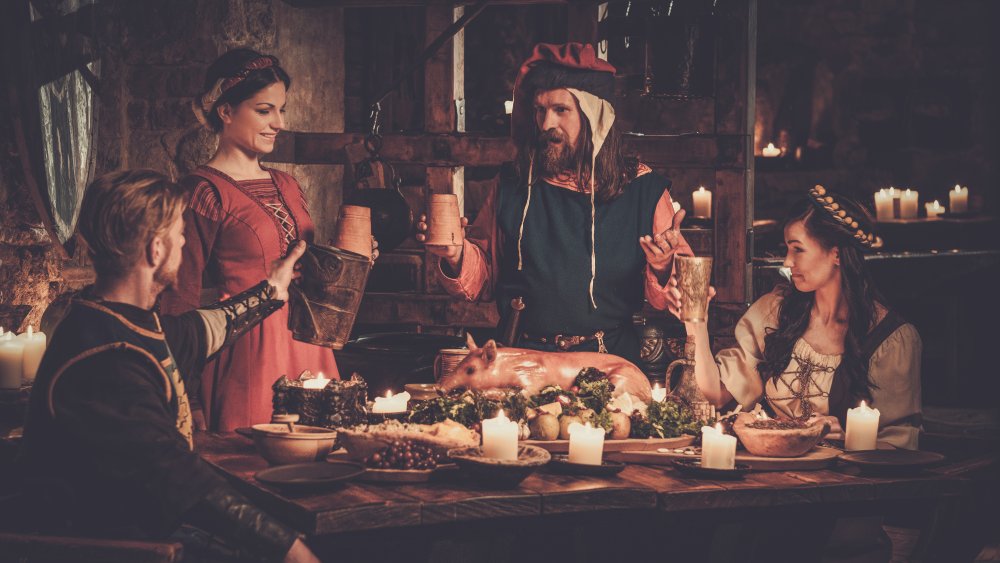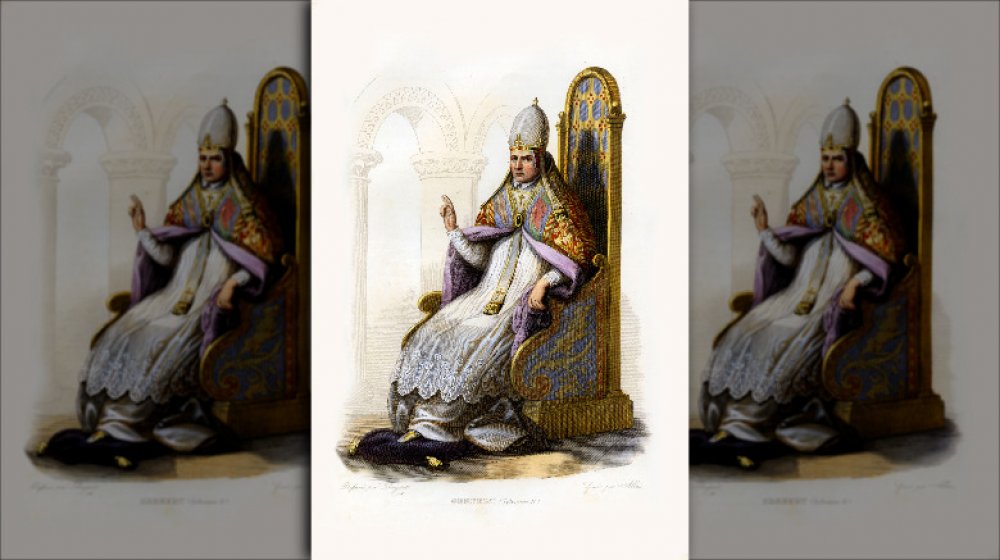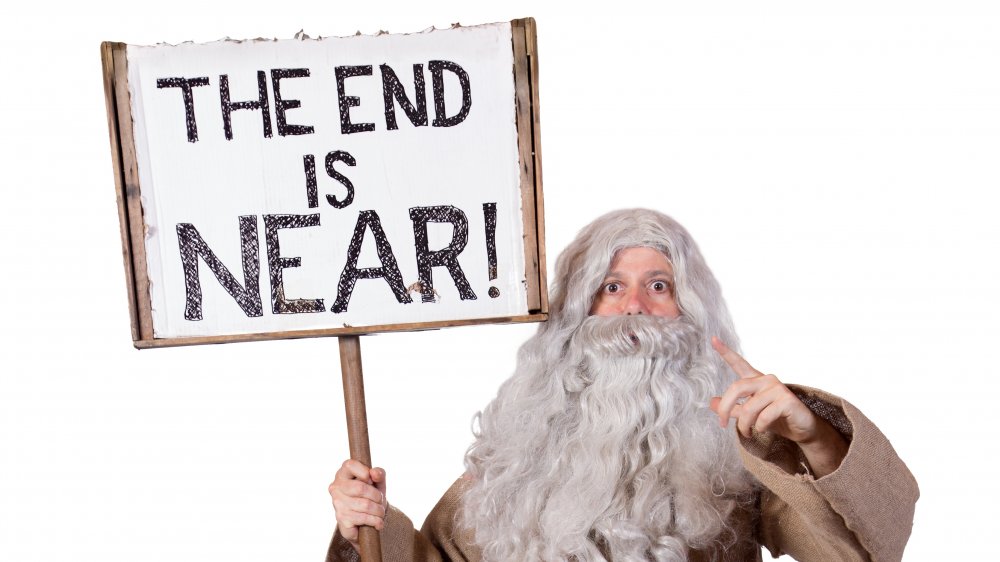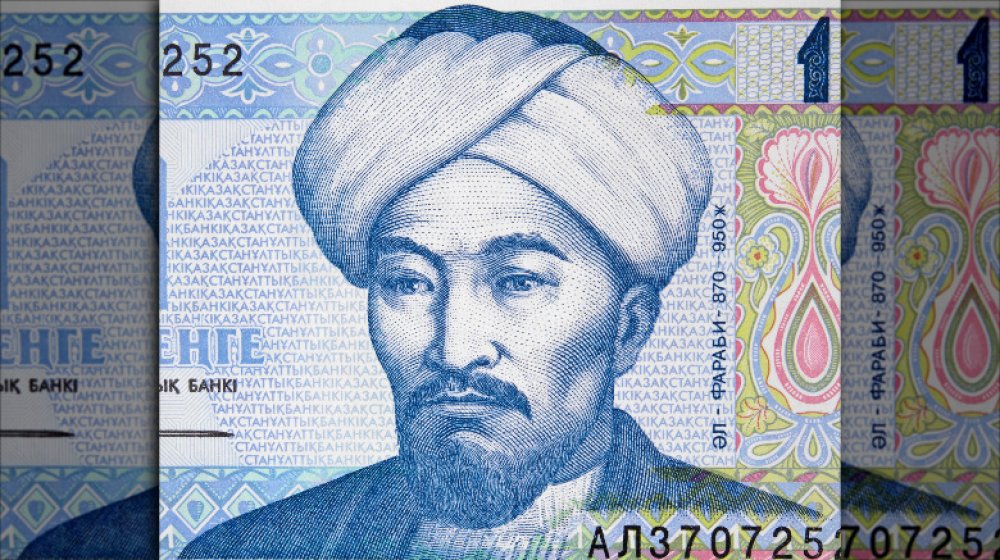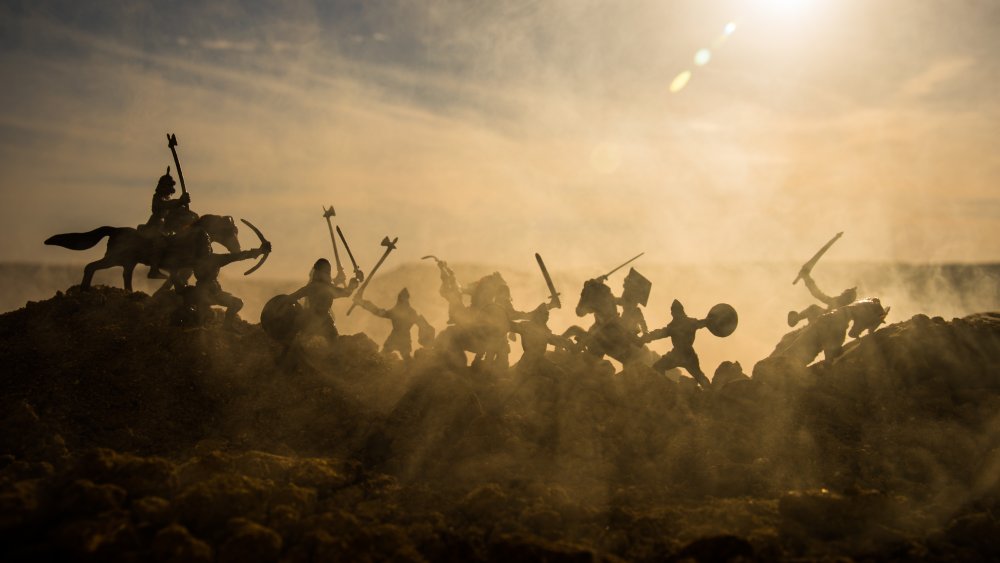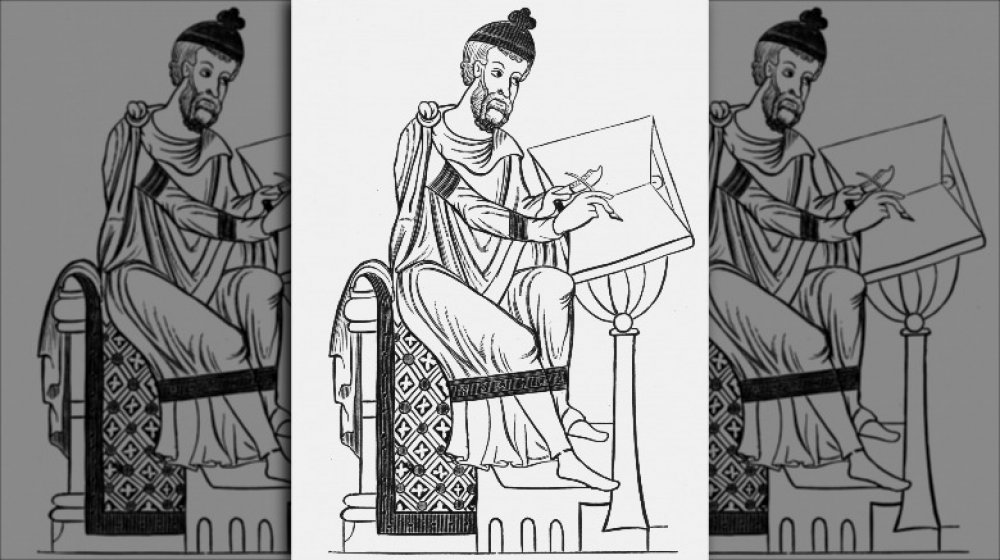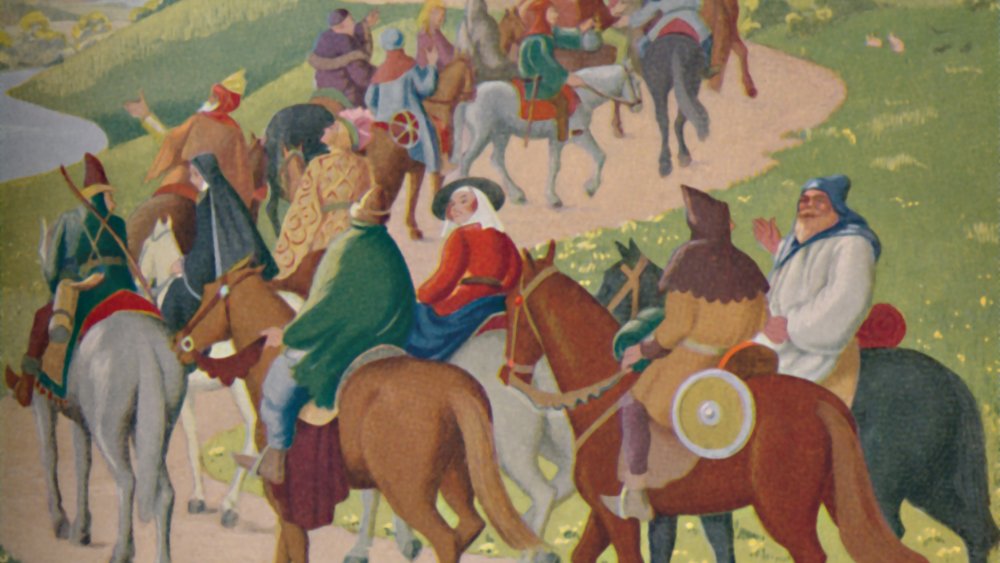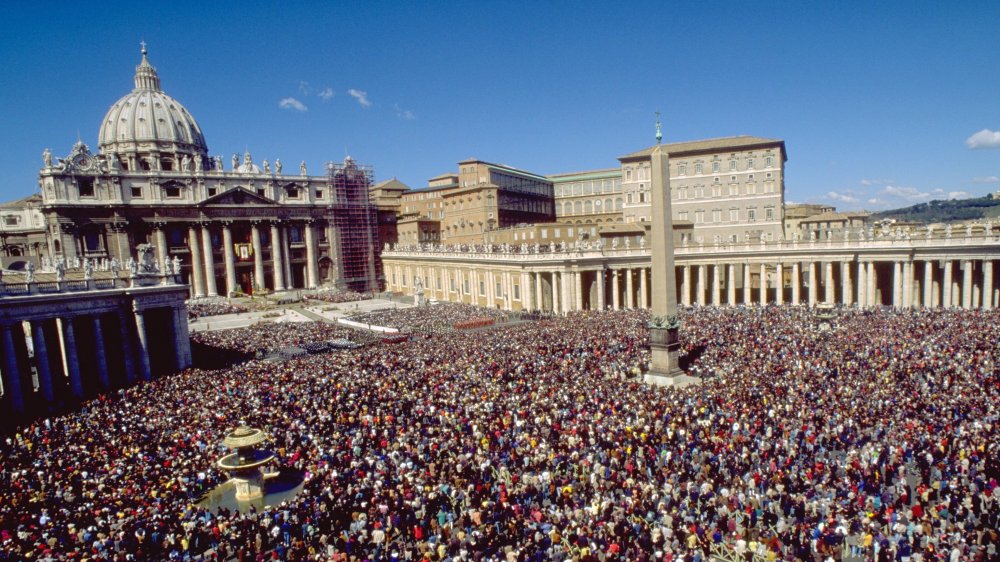What It Was Really Like On New Year's, 1000 AD
Time is tricky stuff. Few other aspects of the human condition are as subject to our own prejudices and perception as time — sometimes it seems to pass quickly, sometimes it seems to stand still, and it's always relative. That doesn't stop us from trying to organize time into neat little bundles: minutes, days, years. But these units of measurement are invented, as are the calendars we use to mark history. The calendar system we use today can be traced back to a system invented by Julius Caesar in 46 BC, and the fact that it requires leap years is all you need to know about how accurate it is.
Still, humans have a habit of imbuing the calendar with special meaning, and no date gets more attention than New Year's Eve. The end of a year and the beginning of the next has always been cause for celebration, introspection, and superstition, but as we saw in 1999 when Y2K was a thing, it's also a time for fear, uncertainty, and doubt.
It wasn't so different 1,000 years ago — there was a lot of drama surrounding the year 999. But it was a little different. Human nature doesn't change much over the course of a millennium, but technology, knowledge, and culture change a lot. Here's what it was really like on New Year's, 1000 AD.
No one was quite sure when New Year's was
In the modern era, we've got New Year's locked in. Every December 31, thousands of people cram into public space like Times Square to shout and cheer when the clock strikes midnight. We watch really terrible shows on television, pop champagne, and wear ridiculous hats. Even the slight complexity of time zones is no big deal — everyone roughly agrees on when the new year begins, if only symbolically.
That wasn't the case in 999, because different cultures celebrated the new year on different days (if they even agreed on what year it was in general). As historians Frances and Joseph Gies note, some places marked the new year on March 1, some on January 1, some on December 25, some on March 25. You could literally travel through three different years just by going from Venice to Florence to Pisa.
Making it more complicated, as noted by Medievalists.net, countries switched when they celebrated the new year over time. In England, the traditional new year was celebrated on December 25 for a while, then March 25, and finally pinned to January 1 in 1752. And that's just the cultures that followed the Julian Calendar — many Asian and Islamic cultures didn't. This means that while people celebrated the new year back then, it wasn't one huge worldwide party like it is today. It was spread out over essentially a four-month period.
Y1K was the fear of a literal apocalypse
If you were alive in 1999, you might remember Y2K. As National Geographic reminds us, Y2K referred to a glitch in computer code: A lot of the code that ran important systems, like banking or power grids, had been written back when memory limitations required dates be stored as a two-digit number. The fear was that when the years changed from 19xx to 20xx, computer systems would crash. There was real panic surrounding this — people believed modern society might literally shut down the second we hit midnight on January 1, 2000.
Of course, this didn't happen. Computer engineers were aware of the problem for decades and worked hard to fix it. Back in 999, people were also worried about an apocalypse — but not the technological kind. In the Christian world, they were worried about a literal apocalypse, the kind described in the Bible and involving the Second Coming of Jesus Christ. As historian Suzanne Comte reports, many people figured 1,000 years was a significant number and expected the judgment to come with a blast of trumpets from the air "at any minute."
This was backed up by events. Christian forces were taking a beating everywhere from heathens. As author James Reston notes, non-Christian groups like the Magyars, the Vikings, and the Moors had been winning battles against Christian armies for decades. It really did seem like the end of the world was coming, giving extra significance to the year 1000.
There was a recalculation
Two things define doomsday cults throughout history: One, they've all been wrong (so far), and two, they almost always claim they miscalculated and come up with a revised date for the end of the world. This was true back in 1000, when the apocalypse failed to arrive as predicted by many.
As historians Robert Lacey and Danny Danzinger note, when the year 1000 failed to be the end of the world, folks recalculated. The problem, it was decided, was simple: Everyone had been counting from the year zero, supposedly (if inaccurately) the year of Christ's birth. What they should have been doing, as The Independent explains, was counting from the year of Christ's death, which made 1033 the actual year of the actual apocalypse.
Of course, the year 1033 came and went without the apocalypse as well. But predicting the apocalypse is just something that human beings like to do, and everyone always thinks they're living in the Worst of All Possible Times, so it always seems compelling. People kept calculating new dates — sometimes using curious math to do so. Smithsonian Magazine notes that one date chosen for the apocalypse was the super-specific 1504, based on some pretty interesting interpretations of Bible verses.
Many thought the pope was the Antichrist
The pope hasn't always been seen as a kindly old man in a white costume whose purity is unquestioned. As Esquire notes, the year 999, in fact, was just a few decades after the period known as the "pornacracy," when several popes were known to have had mistresses, had people murdered, and lived lavish lifestyles. By 999, the reputation of the papacy was not great.
So it's not terribly surprising that when a new pope, Gerbert Of Aurillac (taking the regnal name Sylvester II), ascended in 999, he was widely regarded as the Antichrist, the person the Bible says will oppose Christ before the apocalypse. For one thing, as historians Frances and Joseph Gies note, Sylvester was a very smart and learned man, and nothing convinces people you're in league with Satan like an education.
As Popular Mechanics points out, Sylvester leaned into this by actually predicting the end of the world in 1000. Even today, if the pope popped up on CNN telling you the world was ending, you'd pay attention, and in 999, this was pretty triggering stuff for Catholics everywhere. For some, however, this just sealed their opinion that Sylvester was partnered with the Devil and probably his agent on Earth — aka the Antichrist.
The end of the world was kind of a common event
You might think that the end of the world would be something kind of exciting. If someone convinced you that the world was ending in 2020 (really, not difficult to do at this point), you'd probably freak out quite a bit.
But people were kind of used to it back in the day. While the year 1000 definitely inspired a lot of apocalyptic talk, the truth is that predictions of the end of the world were so common that people kind of took them in stride back then. Historians Frances and Joseph Gies note that the Bible isn't very specific about the date of the apocalypse, so people were prepared to accept that just about any year could be the end of everything.
As The New York Times reports, back in medieval times, people accepted that the apocalypse could happen at literally any time — in 899, 999, 1033, or just about any year ending in 99. People probably went to lunch every day prepared for a blast of trumpets to announce the Second Coming. There was no shortage of alarming events to support this expectation, either: Every year brought a famine, a plague, or an invasion by a marauding heathen army, any one of which could be reasonably interpreted as a sign of the End Times.
Non-Christians were too busy winning
The thing about the year 1000 is that it's a product of the Anno Domini system of calculating years based on the assumption that you're a Christian – anno domini literally means "year of our lord" and refers to Jesus Christ. As Live Science explains, the system was first introduced in the sixth century by a monk trying to figure out exactly when Easter should be celebrated.
For anyone following the AD system, the year 1000 sure seemed significant. Add in a few apocalyptic events like losing wars to non-Christian forces, famines, or plagues, and it was easy for folks to come to the conclusion that the world was ending.
But outside Christendom, it wasn't the year 1000. Other cultures had their own calendars, and they were doing much better than Christian Europe at the time. As National Geographic points out, Muslims were experiencing a Golden Age. Not only were they steadily conquering the world, but they were leading in science, math, and the arts. And History Magazine notes that for China, the year 1000 also represented a high point in their cultural and scientific endeavors — that's about when they invented gunpowder. In other words, for anyone outside of Christian Europe, the year 1000 wasn't the year 1000, and the world wasn't ending.
The lack of an apocalypse in 1000 led directly to the Crusades
One surprising aspect about the year 1000 and the apocalypse is how stoked a lot of people were. For a lot of people living 1,000 years ago, this was exciting stuff, possibly due to a distinct lack of Netflix and a distinct oversupply of deadly diseases and other miseries. There was actually a lot of disappointment when New Year's 1000 came and went without much fuss.
As noted by Britannica, people's confusion about the world not ending fed into a new idea — that the apocalypse needed the right conditions on the ground. God wasn't going to trigger the end of all things unless humanity was ready for it. Because humans solve all problems with violence and bloodshed, this led directly to the idea that what was needed was a "Kingdom of God," which meant conquering all those irritating heathens.
According to historian Charles W. Connell, in 1095, Pope Urban II noticed that according to the Bible, one of the key events of the apocalypse would be when the Antichrist attacked three Christian kings in Africa. Since there were no Christian kings in Africa, the apocalypse obviously couldn't happen. The solution was simple: Put together an army and conquer all those places and put Christian kings in power — thus triggering the end of the world. In other words, the lack of an apocalypse in 1000 led directly to the Crusades.
Everyone agreed the world was in decline
As the new year approached Europe in 999, it's easy to understand why so many expected the world to end — and were actually happy about it. The world certainly seemed to be in the midst of a permanent decline. As SFGate notes, the church had been rocked by endless scandals involving sex, money, and general skulduggery. The old order of the Holy Roman Empire was crumbling into chaos, and non-Christian forces had been steadily invading for centuries.
Everyday life wasn't so grand, either. The bulk of the population was illiterate and ignorant. Crop failures and epidemics were incredibly common, leading to famines and mass death. And because of that aforementioned ignorance and illiteracy, all the earthquakes, floods, and other natural disasters were terrifying — impossible to predict and easy to interpret as the judgment of a very, very disappointed god.
As History Extra notes, one example of this sort of thinking is Archbishop Wulfstan's Sermon of the Wolf to the English, written circa 1009 AD. The Danes were invading England and doing a lot of damage, and Wulfstan saw it as evidence that God was punishing them for their sins in preparation for the end. He wrote: "This world is in haste, and approaches its end. And so it is the worse in this world the longer it goes on, and because of the people's sins it must needs worsen from day to day, until the coming of Antichrist."
There were mass pilgrimages to Rome
These days, everyone likes to gather in Times Square for New year's Eve. Back in 999, everyone wanted to road trip to Rome in order to attend mass. In fact, since the date of the apocalypse was never certain, this was a pretty popular New Year's tradition for a few centuries, beginning in the 900s. As Popular Mechanics notes, the pope in 999 (Sylvester II) encouraged this by predicting the end of the world. But as historian John Howe makes clear, mass pilgrimages to Rome were pretty common throughout the tenth and 11th centuries.
As The Metropolitan Museum of Art points out, making a pilgrimage to Rome or other holy places was part tourism, part celebration. People wanted to see the physical places where saints were buried or where holy events were said to have occurred. They wore special clothes that marked them as pilgrims, and a whole network of churches and monasteries sprang up to offer them food and shelter on their travels.
As art historian Vivienne Morrell notes, the possibility that the year 1000 would be the apocalyptic year everyone had been waiting for inspired a major rise in the number of people undertaking the pilgrimage to Rome before it was too late — and as depicted in Chaucer's Canterbury Tales, these pilgrims usually traveled in groups, telling stories, singing songs, and sharing each other's company. In other words, they partied like it was 999.
Just about everyone fought crime
A lot of historical fiction (and fantasy that's based on medieval cultures) glosses over the medieval lack of law and order. Sure, there were laws, but there weren't any organized police forces or developed legal mechanisms. Now add in class of men who are required to be literal living war machines but who often find themselves both impoverished and with nothing whatsoever to do — knights — and you've got a recipe for disaster.
As Britannica notes, the chaos that swallowed Europe in the wake of the collapse of the Carolingian dynasty meant that local governments were consumed with feuds and petty wars. The ability of those in charge to protect the common people — and the church — dropped to about zero. That meant that violence and crime became a real problem, and when that translated to folks with swords barging into churches and monasteries and taking what they pleased, someone got the bright idea to start the Peace of God movement.
The general idea was to gather all the local people, at swordpoint if necessary, and make them all swear to uphold the law and protect people. Oh, and to protect the church's valuable property, by sheer coincidence. These gatherings became fairly common in the late tenth century, especially as people expected the apocalypse to happen around 1000, thus making it a priority to bring the "heavenly order" down to Earth to prepare the way.
A lot of people weren't even aware that it was 1000 AD.
In modern times, every time you glance at your phone, you're reminded what year we're living through. It's actually impossible to be confused on this point, which is why every time a character in a time travel story demands to know what year it is, they get some strange looks.
But back in 999, that wasn't the case. Not only were there no phones, but there wasn't even a single uniform way of telling time. Different cultures had different calendars and counted the years differently, but it goes beyond that. As Medieval Genealogy explains, in much of medieval Europe, the regnal year of the reigning monarch was used to mark time, and most of the common people, who were uneducated and typically illiterate, used feast days and the seasons as time markers, not necessarily the year.
In fact, as historian David Ewing Duncan makes clear, most people in the year 1000 wouldn't have cared what year it was because it simply wasn't information they needed to know. The season or feast day had a direct impact on their lives — but the precise year didn't. As a result, many people would have been unaware that the year 1000 was coming in the first place.
There was a huge mass in Rome on New Year's Eve, 999
For those in Europe who were aware of what year it was and who had the time and resources to travel, there was only one destination worth traveling to: Rome.
A new pope was installed that year: Sylvester II. Many people took the timing of the new pope to be a sign, and the countdown to the end of the world began in earnest once Sylvester arrived. The significance of the year wasn't lost on him, either. As Popular Mechanics reports, he lost no time in announcing that the end was nigh and that the Second Coming was, well, coming. As Gerald L. Stevens notes, Sylvester announced a mass on New Year's Eve, 999, fully expecting some serious fireworks to break out when the new year dawned.
It was the "ball drop" of its time. Thousands of people descended on Rome to attend the mass. Riots broke out, and order broke down as people went into a frenzy, fulling expecting the world to end. When it didn't, everyone simply assumed they'd made a math error, with most people deciding that the real date of the apocalypse was the year 1033, 1,000 years after Christ's death. Sylvester wasn't there to hold that mass, though — he died in 1003.
